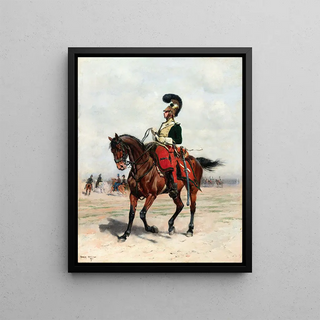Art print | A cavalry officer - Jean-Baptiste Édouard Detaille


View from behind

Frame (optional)
The artwork "Un officier de cavalerie" by Jean-Baptiste Édouard Detaille is a true ode to military heroism and the grandeur of the past. Painted at the end of the 19th century, this painting embodies not only the spirit of the era but also the enduring fascination with epic tales of war and courage. Detaille, through his virtuoso brushwork, transports us to a universe where the bravery of cavalrymen is highlighted, revealing a captivating aesthetic that continues to inspire. The art print of this piece allows for an appreciation of the meticulous details and the richness of colors, offering an immersive glimpse into the military life of that time.
Style and uniqueness of the work
Detaille's style is characterized by striking realism, which manifests in every brushstroke. "Un officier de cavalerie" stands out for its ability to capture not only the appearance of uniforms and mounts but also the intensity of human emotions. The expressions of the characters, the proud posture of the officer, and the dynamism of the scene demonstrate exceptional technical mastery. The composition is carefully orchestrated, with each element positioned to guide the viewer's eye toward the central hero. The nuances of light and shadow, along with the choice of colors, create a vibrant, almost tangible atmosphere. Detaille manages to breathe life into his subjects, making this work not just a painting but a window into a bygone era.
The artist and his influence
Jean-Baptiste Édouard Detaille, an emblematic figure of the realist movement, made a name for himself in the art world through his passion for depicting military scenes. Born in 1848, he was deeply influenced by the events of his time, particularly the wars that marked France. His work reflects an era where art and war intertwined, where painting became a means of glorifying military actions. Detaille established himself as a visual chronicler of battles, paying tribute to the bravery of soldiers while exploring the complexity of human conflicts. His influence extends to

Matte finish

View from behind

Frame (optional)
The artwork "Un officier de cavalerie" by Jean-Baptiste Édouard Detaille is a true ode to military heroism and the grandeur of the past. Painted at the end of the 19th century, this painting embodies not only the spirit of the era but also the enduring fascination with epic tales of war and courage. Detaille, through his virtuoso brushwork, transports us to a universe where the bravery of cavalrymen is highlighted, revealing a captivating aesthetic that continues to inspire. The art print of this piece allows for an appreciation of the meticulous details and the richness of colors, offering an immersive glimpse into the military life of that time.
Style and uniqueness of the work
Detaille's style is characterized by striking realism, which manifests in every brushstroke. "Un officier de cavalerie" stands out for its ability to capture not only the appearance of uniforms and mounts but also the intensity of human emotions. The expressions of the characters, the proud posture of the officer, and the dynamism of the scene demonstrate exceptional technical mastery. The composition is carefully orchestrated, with each element positioned to guide the viewer's eye toward the central hero. The nuances of light and shadow, along with the choice of colors, create a vibrant, almost tangible atmosphere. Detaille manages to breathe life into his subjects, making this work not just a painting but a window into a bygone era.
The artist and his influence
Jean-Baptiste Édouard Detaille, an emblematic figure of the realist movement, made a name for himself in the art world through his passion for depicting military scenes. Born in 1848, he was deeply influenced by the events of his time, particularly the wars that marked France. His work reflects an era where art and war intertwined, where painting became a means of glorifying military actions. Detaille established himself as a visual chronicler of battles, paying tribute to the bravery of soldiers while exploring the complexity of human conflicts. His influence extends to






